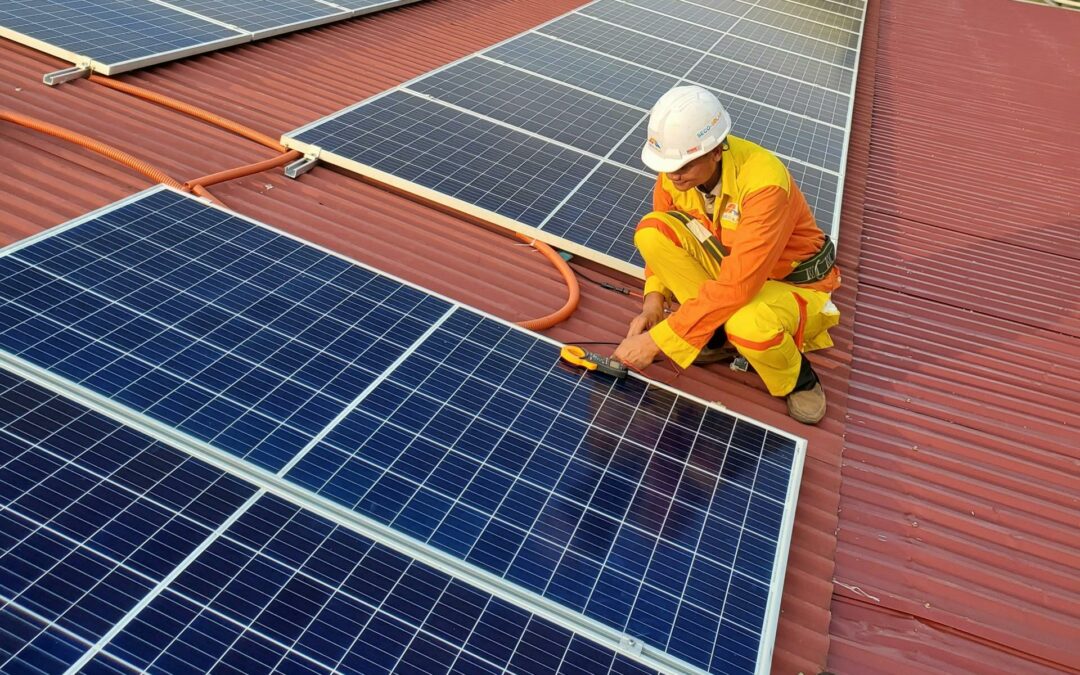As energy bills– and demands for sustainable energy solutions– continue to rise, homeowners are increasingly turning to solar energy systems to power their homes. One popular trend for people who are exploring renewable energy options is the integration of solar panels with metal roofing.
In this guide, we’ll explore the benefits of combining solar energy and metal roofing systems, providing valuable insights to the proper installation techniques required to maximize energy production and preserve roof structural integrity and longevity.
Understanding Solar Panels on Metal Roofs
Installing solar panels on metal roofs involves applying photovoltaic (PV) panels directly onto the roof’s surface. This method offers several advantages, including the durability and longevity of metal roofing materials, which can provide a stable foundation for solar panel installation.
Whether the roof is a standing seam metal roof or stone-coated steel, the compatibility of various metal roofing types with solar panels makes them an attractive option for homeowners who are looking to harness the power of solar energy.
Assessing Roof Compatibility
Before proceeding with solar panel installation, it’s essential to assess the compatibility of your metal roof. Factors like roof pitch, orientation relative to the sun’s path, and structural integrity play crucial roles in determining the feasibility of solar panel installation.
Enlisting the help of a qualified metal roofing expert to inspect your roof can help you to identify any potential issues or limitations that may need to be addressed before installation begins.
Selecting Solar Mounting Solutions
There are various mounting options available for installing solar panels on metal roofs. Some of these options include solar roof hooks, clamps, and rail systems.
Each method has advantages and considerations, depending on the type of metal roof and project requirements. Consulting with a qualified installer can help you to determine the most suitable mounting solution for your specific needs.
Preparing for Installation
Proper preparation is key to ensuring a successful solar panel installation on a metal roof. This includes cleaning the roof surface to remove debris and applying sealants to seal penetrations and ensure waterproofing. Following manufacturer guidelines and local building codes is essential for guaranteeing a safe, effective installation process.
Ensuring Waterproofing and Weatherproofing
Effective waterproofing and weatherproofing measures are essential to protect the integrity of the metal roof and prevent leaks or damage over time. This may involve installing flashing around roof penetrations, applying sealants to seams and connections, and using proper attachment methods to secure solar panels in place.
Integrating with Existing Roof Features
Integrating solar panels with existing roof features such as vents, chimneys, and skylights requires careful planning and consideration. Some solutions may include adjusting panel placement to accommodate roof features or using specialized mounting hardware to maintain functionality and aesthetics while maximizing solar energy production.
Testing and Commissioning
Once the installation is complete, thorough testing and commissioning are necessary to ensure that the solar energy system operates efficiently and complies with local regulations. This involves checking electrical connections, testing system performance, and verifying compliance with safety standards. Regular maintenance and monitoring can help to optimize system performance, and even prolong its lifespan.
Sustainable and Cost-Effective
Installing solar panels on a metal roof offers homeowners a sustainable, cost-effective way to harness solar energy and reduce their carbon footprint. Understanding the key steps and considerations involved in the installation process allows homeowners to make informed decisions and helps to ensure a successful transition to renewable energy.
As always, we recommend consulting with qualified professionals and adhering to industry best practices to achieve optimal results and enjoy the benefits of your solar panels for years to come. If you’ve got questions, it’s time to give us a call!

